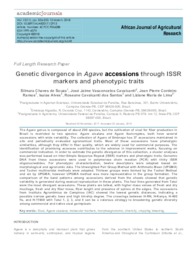Genetic divergence in Agave accessions through ISSR markers and phenotypic traits.
Genetic divergence in Agave accessions through ISSR markers and phenotypic traits.
Author(s): SOUZA, S. C. de; CAVALCANTI, J. J. V.; RAMOS, J. P. C.; ALVES, I.; SANTOS, R. C. dos; LIMA, L. M. de
Summary: The Agave genus is composed of about 200 species, but the cultivation of sisal for fiber production in Brazil is restricted to two species: Agave sisalana and Agave fourcroydes, both have several accessions with wide variability. The collection of Agave of Embrapa has 37 accessions maintained in situ and periodically evaluated agronomical traits. Most of these accessions have phenotypic similarities, although they differ in fiber quality, which are widely used for commercial purposes. The identification of promising accesses contributes to the advance in improvement works, focusing on commercial indication. In order to estimate the genetic divergence of this collection, a cluster analyses was performed based on Inter-Simple Sequence Repeat (ISSR) markers and phenotypic traits. Genomic DNA from these accessions were used in polymerase chain reaction (PCR) with thirty ISSR oligonucleotides. For phenotypic characterization, twelve descriptors were adopted based on morphological and agronomic data. The Unweighted Pair Group Method with Arithmetic Mean (UPGMA) and Tocher multivariate methods were adopted. Thirteen groups were formed by the Tocher Method and six by UPGMA; however UPGMA method was more representative in the group formation. The comparison of the band patterns among accessions derived from the shoots showed that genetic variability is generated during asexual reproduction in these plants. The four lines generated from Tatui were the most divergent accessions. These plants are tallest, with higher mass values of fresh and dry mucilage, fresh and dry fiber mass, fiber length and presence of spines at the edges. The accessions from Instituto Agronômico de Campinas (IAC) showed the lowest genetic distances, indicating a possible narrow genetic base and high kinship degree. The crossings between H-RN, H-Kenya, H-400 fls, and H-11648 with Tatuí 1, 2, 3, and 4 can be a valorous strategy to broadening genetic diversity among commercial and native sisal germplasm.
Publication year: 2018
Types of publication: Journal article
Unit: Embrapa Cotton
Observation
Some of Embrapa's publications are published as ePub files. To read them, use or download one of the following free software options to your computer or mobile device. Android: Google Play Books; IOS: iBooks; Windows and Linux: Calibre.
Access other publications
Access the Agricultural Research Database (BDPA) to consult Embrapa's full library collection and records.
Visit Embrapa Bookstore to purchase books and other publications sold by Embrapa.

